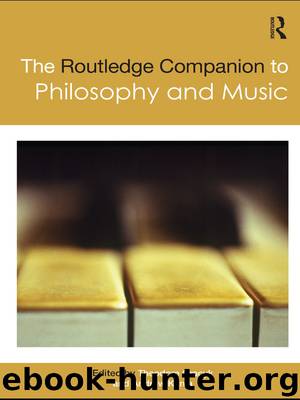The Routledge Companion to Philosophy and Music by Gracyk Theodore; Kania Andrew;

Author:Gracyk, Theodore; Kania, Andrew; [THEODORE GRACYK & ANDREW KANIA]
Language: eng
Format: epub
Publisher: Routledge
Published: 2011-10-31T16:00:00+00:00
Music in the Republic
The Republic’s main discussion of music occurs in Book 3, 398c–403c. Two general features of this discussion bear out points already adumbrated above: first, the treatment of music stands as an adjunct to, and complements, the principles laid down for the content and form of poetic texts at 2.376e–3.398b; second, the whole poetico-musical side of education (the part dealing with the psyche just as gymnastics deals primarily with the body) is called mousikê at 2.376e and subsequently. So the analysis of music proper is presented as one facet of the philosophical regulation of an educational, psychological and cultural constellation of activities. Socrates considers rhythmic and melodic structures (the latter taking the form of harmoniai: tunings, modes or scales, Barker 1984: 163–8) as elements in compound art forms; they work in liaison with the discursive logos of the texts they accompany (398d). But he nonetheless ascribes to those musical structures expressive qualities of their own.
The nature of those qualities is brought under the heading of mimesis, a concept normally rendered as “imitation” by most modern translators and scholars but which often functions in ways that overlap with later ideas of representation and expression (Halliwell 2002). Socrates introduces mimesis at 2.373b as a compendious category of imaginative simulation as practiced in both visual and musico-poetic art. He later employs a narrower definition of the term to cover the dramatic or “enactive” mode of poetic discourse (3.392d) as opposed to poetry in third-person narrative. These uses of the terminology of mimesis cannot be reduced to a conceptually tidy essence. When Socrates starts to speak of melodic/modal mimesis at 3.399a–c, his meaning is not self-evident. But he clearly supposes some kind of expressive correspondence or correlation (a sort of isomorphy of “movement,” according to Politicus 306c–7c, a later work) between musically organized sounds and the emotional-cum-ethical traits of characters depicted in poetic texts. On this understanding, followed in many respects by Aristotle Politics 8.5 (Halliwell 2002: 234–49), music allows processes and impulses of feeling to be captured in the movements of sound and thereby transmitted to and replayed by other minds.
Socrates advances here a fundamentally “narrative” model of musical semantics. He works with a principle on the lines of “prima le parole, poi la musica” (399e–400a, 400d). His prescriptive choices/exclusions of musical modes (un)suitable for the poetry which will be performed by young guardians, that is, future rulers, in the ideal city (Callipolis) are an extension of the judgments which he earlier made on (un)desirable poetic representations of characters and their attitudes. Thus, for instance, his exclusion of modes or tunings expressive of “lamentation” (398d–e) is aligned with his earlier repudiation of poetry which depicts gods as causing, and heroes as afflicted by, circumstances of tragic suffering (387d–8d). Socrates (or Plato) does not purport to be offering a comprehensive account of the possibilities or uses of music. He is testing the logic of a model of musical significance (ultimately, its capacity to find expressive equivalents to the defining qualities of particular
Download
This site does not store any files on its server. We only index and link to content provided by other sites. Please contact the content providers to delete copyright contents if any and email us, we'll remove relevant links or contents immediately.
The Goal (Off-Campus #4) by Elle Kennedy(12430)
Kathy Andrews Collection by Kathy Andrews(10518)
Diary of a Player by Brad Paisley(6866)
What Does This Button Do? by Bruce Dickinson(5527)
Assassin’s Fate by Robin Hobb(5236)
Big Little Lies by Liane Moriarty(4880)
Pale Blue Dot by Carl Sagan(4001)
Sticky Fingers by Joe Hagan(3454)
The Heroin Diaries by Nikki Sixx(2930)
The Death of the Heart by Elizabeth Bowen(2901)
Beneath These Shadows by Meghan March(2718)
The Help by Kathryn Stockett(2703)
Confessions of a Video Vixen by Karrine Steffans(2673)
How Music Works by David Byrne(2524)
Jam by Jam (epub)(2486)
Harry Potter 4 - Harry Potter and The Goblet of Fire by J.K.Rowling(2416)
Strange Fascination: David Bowie: The Definitive Story by David Buckley(2367)
Petty: The Biography by Warren Zanes(2237)
Darker Than the Deepest Sea by Trevor Dann(2206)
